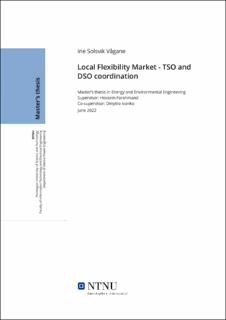| dc.contributor.advisor | Hossein Farahmand | |
| dc.contributor.advisor | Dmytro Ivanko | |
| dc.contributor.author | Vågane, Ine Solsvik | |
| dc.date.accessioned | 2022-10-04T17:23:04Z | |
| dc.date.available | 2022-10-04T17:23:04Z | |
| dc.date.issued | 2022 | |
| dc.identifier | no.ntnu:inspera:108943276:21679653 | |
| dc.identifier.uri | https://hdl.handle.net/11250/3023812 | |
| dc.description.abstract | Akkurat nå er det europeiske energisystemet i endring. Energien som produseres, kommer i større grad fra fornybar energi og desentralisert generasjon. Selv om dette har miljøfordeler, følger det også med en del tekniske utfordringer for markedsoperatørene. Den tradisjonelle måten å drifte strømnettet på er derfor ikke lenger bærekraftig for fremtiden, og det trengs nye måter å regulere kraftsystemet. Én av løsningene kan være å bruke fleksibilitetsressurser.
Denne avhandlingen utforsker forskjellige fleksibilitetsressurser og reguleringene som er relevante for fleksibilitetsmarkedet. Den undersøker hvordan et fleksibilitetsmarked driftes og hvordan markedsdeltagere organiseres. Analysen understreker viktigheten av god koordinering mellom TSO og DSO-ene for å ha et velfungerende kraftsystem.
Deretter evaluerer avhandlingen forskjellige fremgangsmåter for å koordinere et fleksibilitetsmarked, med utgangspunkt i diverse publikasjoner. Fremgangsmåtene ble vurdert og sammenlignet, og lokal fleksibilitetsmarked ble valgt som basis for forskningen. Hvordan dette markedet skulle blir klarert ved hjelp av OPF modell ble introdusert og analysert, med spesielt fokus på koordineringen mellom TSO og flere DSO-er. Det blir introdusert to hovedmetoder for å håndtere koordineringen; bi-level optimering og dekomponeringsmetoden. Etter sammenligning og vurdering, blir dekomponeringsmetoden valgt som metode for å koordinere TSO og DSO-ene.
Til slutt er Hybrid AC/DC-OPF ADMM modellen testet for å se om fleksibilitetsressursene kan være til fordel for driften av TSO og DSO-ene. Av denne grunn er testforsøket basert på ett transmisjons- og tre distribusjonsnett, som er utviklet og basert på Pandapower og Distribution Network Generator (Ding0). Nettene er utsatt for forskjellige nettproblemer, som spenningsovertredelser, flaksehals i distribusjonsnettet og flaskehals i transmisjonsnettet. Resultatene viser at fleksibilitetsressursene er til fordel på mange måter for det distribusjonssystemet de er plassert i. Kostnadene, aktive tap og spenningsprofilene er alle forbedret med fleksibilitetsressursene. Likevel, for dette testforsøket med begrensede fleksibilitetsressurser, kunne ikke DSO-ene hjelpe hverandre med ekstra kraft når det trengtes. | |
| dc.description.abstract | Currently, the energy system in Europe is in transformation. An increasing amount of renewable energy resources and distribution generation is included in the power production. Despite positive environmental effects, these technologies create additional challenges for the market operators in managing the operation of their grids. Therefore, the traditional way of operating the grids are no longer sustainable for the future. New ways of regulating the power system are needed. Using the flexibility assets from distribution grid is an effective way to address potential grid challenges.
First, the thesis explores the different flexibility resources and regulations that are relevant to a flexibility market. It reviews how the operation and main parts of the flexibility market are structured. The review shows that coordination between TSO and DSOs are important for proper and efficient functioning of flexibility market.
Thereafter, the thesis evaluates various approaches from existing materials on TSO-DSO coordination. Several approaches of a power market coordination are compared, and the local flexibility market concept is selected as a basis for this research. The clearing procedure for this type of market using OPF models is introduced and analyzed. Particular attention is given to a method for coordinating TSOs with multiple DSOs in the flexibility market. There are two main methods for clearing the market in these conditions: bi-level optimization and decomposition method. After their comparison, the decomposition method is selected as more suitable for the tasks of the thesis.
The main part of the thesis focuses on the issues related to flexibility market modelling in conditions when coordination between TSO and multiple DSOs is established. For this purpose the Hybrid AC/DC-OPF ADMM model is developed. In this model, the transmission grid is presented by DC-OPF, and distribution grids are presented by AC-SOC OPF. The connection between these grids are established according to Hybrid AC/DC-OPF model. The ADMM method is used to organize the coordination between TSO and multiple DSOs in this OPF problem.
Finally, the Hybrid AC/DC-OPF ADMM model is tested to see how the flexibility resources can benefit the operation of the TSO and DSOs. For this purpose, the test case, which includes transmission and three distribution grids is developed based on Pandapower and Distribution Network Generator (Ding0). The grids are exposed to several grid issues such as voltage violation, congestion in the distribution system, and congestion in the transmission system. The results show that the flexibility resources benefit from the distribution system they are located at in several ways. The costs, active losses and the voltage profile are improved. Nevertheless, for the considered case with limited number of flexibility resources, the DSOs could not help each other with the extra power when needed. | |
| dc.language | eng | |
| dc.publisher | NTNU | |
| dc.title | Local Flexibility Market - TSO and DSO coordination | |
| dc.type | Master thesis | |
